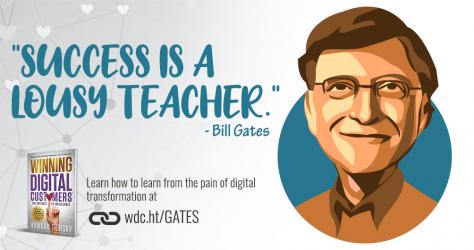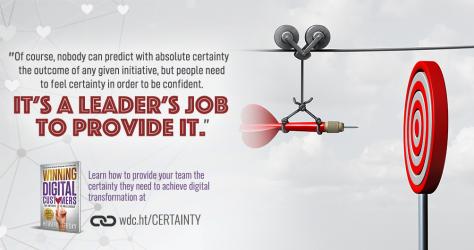One of the core challenges with digital is that it creates the potential for truly transformational change in how a given industry operates. But many companies just aren’t built to transform—in terms of mindset, culture, or even structure. And on an individual level, most people actively resist change; it’s simply human nature. But as a leader, it’s your job to become an expert at the various flavors of “resistance to change” and the tactics to overcome them. The chapter then discusses nine key reasons that people and organizations resist change.
- Evolutionary Psychology: Scientists tell us that most people are actually wired in their DNA to resist change.
- Personal Benefit: For those who have built mini empires within the current structure, a significant shift, might not wind up being in their personal best interest, so they naturally resist it.
- Industrialization Mindset: To a large degree, enterprises today are built on the principle of industrialization, where “experts” figure out how best to produce a product or service, and employees are trained in these methods and expected to comply with them. It can be bewildering and unnatural to lead teams steeped in this mindset through change.
- The Hypnosis of Past Success: Many great legacy brands have a history of success during periods of time when change was not so essential. When faced with the pain of change, it can cause both management and the rank-and-file to question whether such a degree of transformation is truly necessary
- The Forces That Create Silos: The digital experiences that customers love almost always require seamless interaction between many different touchpoints and business areas. However, large organizations are designed in silos—departments, divisions, product teams, even different corporations—that make cross-collaboration difficult.
- Addiction to a Legacy Business Model: Real success in digital usually requires a shift in business model, and companies can become addicted to a certain business model or revenue streams that make it hard to make the leap.
- Lack of Legal Flexibility: Many innovative ideas require a willingness to operate in areas not yet well-defined legally. Large companies tend to be very conservative legally, making it difficult for them to pursue innovative opportunities that smaller companies would seize.
- Investor Expectations: Investors in mature companies have certain financial expectations of quarterly profit and dividends that may not be consistent with major new digital investments. For large enterprises, it can be challenging to get “permission” to change the game and invest in their own future at the level necessary to win.
- Lack of Alignment Around the Solution or Execution: Of course, one reason why people resist change is that they just don’t agree with its direction. Once you have gotten someone to agree that change, in general, is needed, you still need to persuade them to align to a specific change, and good people can disagree on the best direction.
This brings Howard to a discussion of key tactics for overcoming resistance to change.
- Create a Burning Platform for Change: It’s critical to have a strong story around why change is essential and to back it up with data
- Pain a Compelling Vision of the Future: It’s essential to pitch the transformation vision in such a way that you inspire people to want to participate.
- Share Parenthood of the Transformation with Many People: People resist change, but they support change they create. Thus, if you have an idea for an innovation, use cross-collaboration techniques to get people to develop ownership over ideas that are not originally their own.
- Find and Ally with Other Change Agents: In any given enterprise, there are certain people, even if a minority, who are hungry for change. Identify them and bring them onto your team.
- Give People Confidence: Fear of failure is a huge threat, as people will be quick to worry that change is wasting time and money and possibly creating embarrassment. Leaders need to demonstrate the confidence that will empower the organization to deliver at its best.
- Define Clear Goals & Celebrate Signs of Success: Everyone likes to feel like they are part of a winning team and program. The sooner you can start to prove the transformation is working, the faster you will bring more people on board.
- Start the Transformation Where It’s Most Welcome: When it comes to more ambitious transformation, it can be strategic to prioritize your initial efforts in areas of the company that are most welcoming to change and where the barriers are the lowest.
- Sustain Conviction, Especially When Things Go Wrong: There will be tough times. Know in advance that they will come. Then when they do, you must maintain your confidence and commitment, as well as remind stakeholders of the reasons the orga- nization must sustain its commitment.
- Anticipate & Fight the Forces That Will Try to Prevent, Slow, or Reverse Change: There will be forces trying to derail the progress for their own benefit. Keep an eye out for these forces and recognize that half of your job as a transformation leader is dealing with the politics of sabotage and subversion.
- Brand the Transformation: Create an inspirational brand—a slogan and visual identity for the transformation effort that reflects the aspirational vision
- Drive Alignment at All Levels of the Transformation: Sometimes people are ready to change, but they just don’t agree with the current plan. For your colleagues to sustain a feeling of ownership, they need to be given wins along the way in terms of their role in shaping the result. Alignment is more important than perfection. Small compromises may be strategic.
For all this gloom and doom about disagreements and resistance, transformational change absolutely can and does happen. It happens when a leader inspires teams across an organization, aligns them around a clear vision, gets the resources and political support to make it happen, and then anticipates and proactively strategizes how to avoid the potholes along the way.







